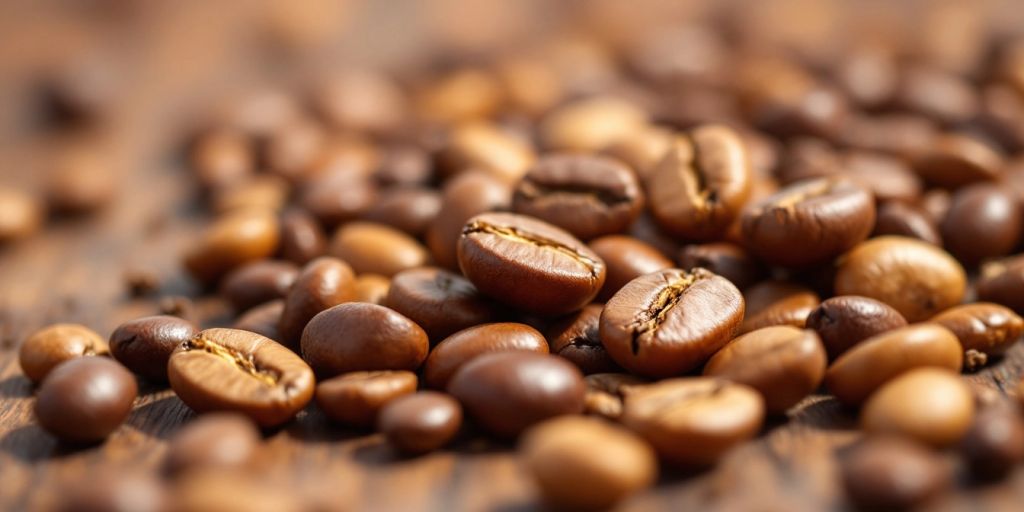Coffee is more than just a drink; it’s a daily ritual for many people. Choosing the right coffee beans can make a big difference in the taste of your cup. This guide will help you understand the different types of coffee beans, their flavors, and how to pick the best coffee beans for your perfect brew.
Key Takeaways
- Select high-quality beans for the best flavor.
- Always use fresh beans; grind them right before brewing.
- Different brewing methods need different grind sizes.
- The quality of water affects your coffee’s taste.
- Try different brewing times and coffee-to-water ratios to find your favorite cup.
Understanding Coffee Bean Varieties
When it comes to coffee, the type of beans you choose can make all the difference. Understanding the varieties is key to brewing your perfect cup.
Arabica Beans: Smooth and Fruity
Arabica beans are the most popular type of coffee bean, known for their smooth and sweet flavor. They often have hints of chocolate and fruit, making them a favorite among coffee lovers. Grown in high altitudes, these beans thrive in cooler climates, which helps develop their rich flavors.
Robusta Beans: Bold and Bitter
Robusta beans pack a punch! With a stronger, more bitter taste and higher caffeine content, they are often used in espresso blends. These beans are easier to grow and can withstand harsher conditions, making them a staple in many coffee blends.
Liberica Beans: Unique and Exotic
Liberica beans are less common but offer a unique flavor profile. They have a floral aroma and a fruity taste, making them an exciting choice for adventurous coffee drinkers. Their irregular shape and size also set them apart from the more traditional beans.
Coffee is not just a drink; it’s an experience that many people cherish daily.
| Bean Type | Flavor Profile | Caffeine Content | Common Uses |
|---|---|---|---|
| Arabica | Smooth, fruity | Lower | Specialty coffee |
| Robusta | Bold, bitter | Higher | Espresso blends |
| Liberica | Unique, floral | Varies | Specialty brews |
Choosing the right coffee bean can elevate your coffee experience. Whether you prefer the smoothness of Arabica, the boldness of Robusta, or the exotic taste of Liberica, understanding these varieties will help you find your perfect brew!
Exploring Single-Origin Coffee Beans
Single-origin coffee beans are sourced from a specific region or farm, showcasing unique flavors that reflect their terroir. These beans offer a taste adventure like no other!
South American Beans: Sweet and Fruity
- Flavor Profile: Clean and sweet, often with fruity notes.
- Notable Regions: Brazil, Colombia, and Peru.
- Best For: Those who enjoy a smooth cup with hints of chocolate and caramel.
African Beans: Bright and Floral
- Flavor Profile: Bright and floral, with complex flavors like berries.
- Notable Regions: Ethiopia, Kenya, and Tanzania.
- Best For: Coffee lovers seeking vibrant and fruity experiences.
Asian Beans: Earthy and Spicy
- Flavor Profile: Heavy-bodied with earthy and spicy notes.
- Notable Regions: Indonesia, Vietnam, and India.
- Best For: Those who appreciate a bold and rich cup.
Exploring single-origin coffees can transform your coffee experience. Each cup tells a story of its origin, making every sip a journey.
Whether you’re a casual drinker or a coffee enthusiast, diving into the world of single-origin beans can elevate your coffee game!
The Importance of Freshness in Coffee Beans

Freshness is essential for a delightful cup of coffee. When coffee beans are fresh, they unlock the best flavors and aromas, making every sip a joy. Prioritizing freshness can transform your coffee experience!
Why Freshness Matters
- Freshly roasted beans burst with vibrant flavors.
- Coffee quickly loses its taste when exposed to air.
- Aim to enjoy your coffee within a few weeks of roasting.
How to Store Coffee Beans
To keep your coffee beans fresh, proper storage is crucial. Here are some tips:
- Use an airtight container to prevent air exposure.
- Store in a cool, dark place to avoid heat and light.
- Keep away from moisture to maintain quality.
Remember, storing coffee beans correctly is crucial to preserving their quality, aroma, and flavor.
Signs of Stale Coffee Beans
Stale coffee can ruin your brew. Look out for these signs:
- Dull aroma that lacks vibrancy.
- Flat taste that doesn’t excite your palate.
- Oily surface on beans indicating age.
By focusing on freshness, you can elevate your coffee experience to new heights!
Choosing the Right Coffee Beans for Your Brew
When it comes to coffee, the right beans can transform your brew. Here’s how to choose coffee beans that suit your taste and brewing style:
Determining Your Flavor Preferences
- Identify your favorite flavors: Do you like fruity, nutty, or chocolatey notes?
- Consider acidity: Some beans are smooth, while others are bright and tangy.
- Think about body: Do you prefer a light, medium, or full-bodied coffee?
Considering Roast Date and Packaging
- Freshness is key: Look for beans roasted within the last 2-3 weeks.
- Check the packaging: Choose beans in airtight bags with one-way valves to keep them fresh.
- Avoid stale beans: If the roast date is missing or too old, skip those.
Whole Beans vs. Ground Coffee
- Whole beans retain flavor longer: Grinding just before brewing gives you the best taste.
- Invest in a good grinder: A quality grinder can make a big difference in flavor.
- Experiment with grind size: Different brewing methods require different grind sizes.
Choosing the right coffee beans is not just about caffeine; it’s about creating an experience that you enjoy every day.
By understanding how to choose coffee beans, you can elevate your coffee game and enjoy every sip!
Mastering Coffee Grinding Techniques
Importance of Grinding Coffee Beans
Grinding coffee beans is a vital step in making your brew. Freshly ground coffee preserves the aroma and flavor, giving you a better cup. Here’s why grinding matters:
- Freshness: Grinding just before brewing keeps the flavors intact.
- Extraction: The grind size affects how quickly flavors are extracted.
- Flavor Control: Different brewing methods need different grind sizes.
Choosing the Right Grinder
When it comes to grinders, you have two main options:
- Burr Grinders: These provide a consistent grind size, which is ideal for even extraction.
- Blade Grinders: More affordable but can create uneven sizes, affecting flavor.
Adjusting Grind Size for Different Brewing Methods
Here’s a quick guide to match your grind size with your brewing method:
| Brewing Method | Grind Size |
|---|---|
| Espresso | Fine |
| Pour-Over | Medium-Fine |
| French Press | Coarse |
| Cold Brew | Extra Coarse |
Remember, the right grind size is the secret ingredient to unlocking the full potential of your coffee. Experiment and find what works best for you!
Tips for Grinding Coffee Beans
- Grind Just Before Brewing: This maximizes freshness.
- Practice Consistency: Aim for a uniform grind size to avoid uneven extraction.
- Clean Your Grinder: Regular cleaning prevents old coffee oils from affecting flavor.
Mastering your grind is essential for brewing the perfect cup. With these tips, you’ll elevate your coffee experience to new heights!
The Appeal of Coffee Blends
Coffee blends are a delightful mix of beans from different places, creating a unique flavor experience. They offer a consistent taste that coffee lovers can rely on, no matter the season. Here’s why blends are so appealing:
Versatility in Brewing Methods
- Blends can be brewed in various ways, making them perfect for any coffee lover.
- They adapt well to different brewing styles, from espresso to pour-over.
- You can enjoy them hot or iced, giving you options for every mood.
Consistency in Flavor
- Blends are crafted to maintain a steady flavor profile throughout the year.
- This means you can expect the same great taste every time you brew.
- Roasters mix beans to balance acidity, body, and aroma, creating a harmonious cup.
Enhancing Flavor Depth
- By combining beans with different characteristics, blends achieve a rich complexity.
- You might taste hints of chocolate, nuts, or even fruity notes, all in one cup.
- This artful combination makes each sip an exciting adventure.
Coffee blends are not just about taste; they’re about creating a memorable experience. Whether you’re at home or in a café, a good blend can elevate your coffee moment.
In summary, coffee blends are all about consistency, versatility, and depth. They cater to every coffee lover’s needs, making them a staple in the world of coffee. So, next time you brew, consider reaching for a blend to enjoy a perfectly balanced cup!
Assessing Coffee Bean Quality

When it comes to coffee, quality is key! The right beans can transform your morning cup into a delightful experience. Here’s how to assess the quality of your coffee beans:
Evaluating Aroma and Appearance
- Aroma: Fresh coffee beans should have a strong, inviting scent. If they smell musty or stale, they’re likely past their prime.
- Appearance: Look for uniformity in size and color. Beans that are all similar in size roast evenly, leading to a better flavor.
- Texture: Quality beans should feel smooth and not have any visible defects.
Understanding Bean Size and Color
| Bean Size | Quality Indicator |
|---|---|
| Large | Higher quality |
| Medium | Average quality |
| Small | Lower quality |
- Color: Lighter beans often yield a milder flavor, while darker beans can be richer and more bitter.
- Shape: For example, Robusta beans are smaller and rounder, often leading to a stronger, more bitter taste.
Identifying High-Quality Beans
- Check for defects: Look for broken or damaged beans, as these can affect the overall taste.
- Research the source: Knowing where your beans come from can help you understand their quality.
- Taste test: The best way to know is to brew and taste! Experiment with different types to find your favorite.
Remember, the quality of your coffee beans can make or break your brew. Choose wisely for the best flavor!
When it comes to coffee, not all beans are created equal. To truly enjoy your cup, you need to know how to assess the quality of the beans. Look for freshness, aroma, and flavor. If you want to dive deeper into the world of coffee and learn more about what makes a great brew, visit our website for tips and insights!
Final Thoughts on Choosing Coffee Beans
Picking the right coffee beans is a fun journey that can really change how you enjoy your coffee. Remember, it’s not just about getting a caffeine fix; it’s about finding flavors that you love. By learning about different types of beans like Arabica and Robusta, and paying attention to things like freshness and how you brew your coffee, you can make each cup special. So, don’t be afraid to try new beans and methods. Enjoy the process of discovering what you like best, and soon you’ll be brewing coffee that makes you smile!
Frequently Asked Questions
What are the main types of coffee beans?
The three main types of coffee beans are Arabica, Robusta, and Liberica. Arabica is known for its smooth flavor, Robusta is stronger and more bitter, and Liberica has a unique taste.
Why is freshness important for coffee beans?
Freshness is key because coffee beans lose their flavor quickly once they are exposed to air. Using fresh beans ensures a better taste in your coffee.
How should I store my coffee beans?
Store your coffee beans in an airtight container in a cool, dark place. This helps keep them fresh and flavorful.
What is single-origin coffee?
Single-origin coffee comes from one specific region or farm. This type of coffee often has unique flavors that reflect its growing conditions.
Should I buy whole beans or pre-ground coffee?
Whole beans stay fresh longer than pre-ground coffee. It’s best to buy whole beans and grind them just before brewing for the best flavor.
How can I tell if my coffee beans are stale?
Stale coffee beans may have a dull aroma, flat taste, or an oily surface. If you notice these signs, it’s time to get fresh beans.



